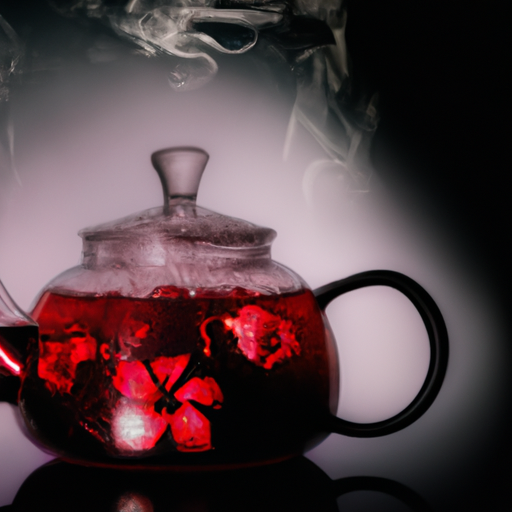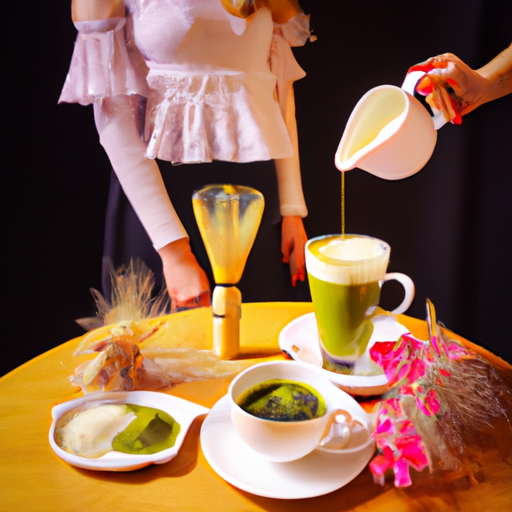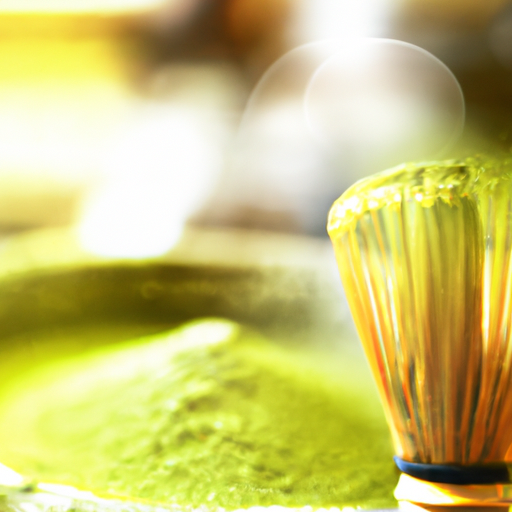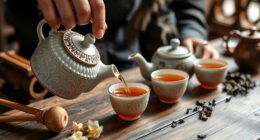A warm tea has an unparalleled ability to comfort the soul and relax the mind. Among herbal teas, hibiscus stands out as a personal favorite of mine, not just because of its lively hue and appealing sour taste, but also due to its array of health advantages.
But if you’re new to brewing hibiscus tea, you might be wondering how to go about steeping it properly. Steeping hibiscus tea is a bit like tending to a garden – it requires patience, attention, and just the right conditions to bring out its full potential.
Just as you wouldn’t expect a plant to thrive without adequate sunlight, water, and nutrients, so too must you give your tea leaves the proper care and attention they deserve. In this article, I’ll walk you through everything you need to know in order to brew a perfect cup of hibiscus tea every time – from choosing the right type of leaves to steeping them at the optimal temperature and duration.
So sit back with your favorite mug and let’s dive in!
Key Takeaways
- Brewing hibiscus tea requires patience, attention, and the right conditions, with the optimal brewing temperature being around 200°F (93°C) and the optimal time to steep being between 5-7 minutes.
- Accurately measuring ingredients is essential to achieving optimal flavor, and boiling water can scorch delicate flavors and damage sensitive brewing equipment, while water that isn’t hot enough may not extract all the beneficial compounds from your tea leaves.
- Adding sweeteners, flavor enhancers, fruits, herbs, or spices can enhance the taste and provide additional health benefits, so choose ingredients that complement each other well and keep in mind their health benefits.
- Proper storage is crucial to maintain the flavor and quality of hibiscus tea, so store leftover tea properly in an airtight glass jar or container in the refrigerator, avoid using plastic containers, and consume leftover tea within 2-3 days for best results.
Understand the Properties of Hibiscus Tea
Hibiscus tea isn’t just delicious, but it’s also rich in antioxidants and vitamin C, making it a healthy drink to enjoy any time of day. Knowing the health benefits and brewing techniques of hibiscus tea can help you make the most of this refreshing beverage.
The first thing to note about hibiscus tea is its high antioxidant content. Antioxidants protect our cells from damage caused by free radicals, which are produced by normal body processes as well as environmental factors like pollution and UV rays. By drinking hibiscus tea regularly, you can support your body’s natural defences against these harmful agents.
In addition to antioxidants, hibiscus tea is also a good source of vitamin C. This essential nutrient supports immune function and helps with collagen synthesis, which keeps our skin looking healthy and youthful. To fully benefit from these health properties, it’s crucial to brew your hibiscus tea correctly.
To choose the right type of hibiscus tea for your brewing needs, consider whether you want loose-leaf or bagged varieties. Loose-leaf teas allow for more customization in terms of how strong or weak you want your brew to be; however, bags are more convenient if you’re short on time or don’t have access to a strainer. Additionally, pay attention to where your hibiscus was sourced from, as some regions may produce higher-quality flowers than others.
With these considerations in mind, let’s move on to learning how to steep our perfect cup of hibiscus tea!
Choose the Right Type of Hibiscus Tea
To get the most out of your cuppa, you’ll want to select the variety of hibiscus that has been shown to reduce blood pressure. Hibiscus sabdariffa, also known as Roselle, is the species that has been scientifically proven to provide numerous health benefits. It contains antioxidants and many other nutrients that help promote good health.
Not only does Roselle offer health benefits, but it also boasts a delicious flavor profile. It is tart and tangy with a slightly sweet aftertaste. The deep red color of the tea adds an inviting vibrancy to any mug or teapot. Whether you enjoy it hot or iced, this type of hibiscus tea is sure to please your palate.
When choosing your hibiscus tea, make sure you opt for high-quality dried flowers or whole calyces. These will provide the best taste and nutritional value.
Now that you’ve selected your preferred variety, let’s move on to measuring the correct amount of tea for steeping without compromising its flavor and health properties.
Measure the Correct Amount of Tea
When measuring the right amount of hibiscus tea for brewing, it’s crucial to use high-quality dried flowers or whole calyces. Here are five measuring tips that I’ve found helpful:
- Use a digital kitchen scale for precise measurements.
- Measure one teaspoon of hibiscus per cup of water.
- Adjust the amount depending on your taste preference and desired strength.
- Don’t pack the tea too tightly when measuring – a loose scoop is better.
- Double-check your measurements before adding them to the pot.
Tea brewing can be a delicate process, and accurately measuring your ingredients is essential to achieving optimal flavor. By following these tips, you’ll ensure that your hibiscus tea turns out perfectly every time.
To bring out the full potential of this delicious drink, it’s important to heat the water to the right temperature.
Heat the Water to the Right Temperature
Achieving the perfect cup of hibiscus tea requires heating the water to the right temperature, which is essential for extracting the full flavor and health benefits. The ideal brewing temperature for hibiscus tea is around 200°F (93°C). To achieve this temperature, you can either use a thermometer or bring the water just to a boil and let it cool for a few minutes before pouring over your tea.
When heating water, it’s important to avoid using boiling water as it can scorch delicate flavors and damage sensitive brewing equipment. Similarly, if the water isn’t hot enough, it may not extract all the beneficial compounds from your tea leaves. A good rule of thumb is to heat your water until it reaches a gentle rolling boil, then turn off the heat and allow it to cool slightly before pouring over your hibiscus tea.
With proper attention given to achieving optimal water temperature, you’ll be well on your way to enjoying a delicious cup of hibiscus tea with all its delightful flavors and health benefits.
In our next section, we’ll discuss how long to steep your hibiscus tea for maximum enjoyment.
Steep the Tea for the Right Amount of Time
Once the water has reached the perfect temperature, let your loose leaf or tea bag brew for a few minutes until its flavors and health benefits are fully released, allowing you to savor every sip of this delightful beverage.
Steeping hibiscus tea is an art that requires patience and consistency. The most common mistake people make is steeping their tea for too long, which results in a bitter taste. The optimal time to steep hibiscus tea is between 5-7 minutes. Anything over that can leave your tea tasting bitter and unpleasant.
When correctly steeped, hibiscus tea offers numerous health benefits, such as reducing blood pressure, promoting weight loss, and boosting liver function.
To get the best out of your hibiscus tea, avoid using boiling water as it can burn the leaves and alter their flavor profile. Instead, use hot water at around 190-200°F (87-93°C).
Once done brewing for the right amount of time, strain your tea to remove any leftover leaves or debris before pouring into your favorite cup.
Strain the Tea
Don’t forget to strain your brewed tea before enjoying it, as leftover leaves or debris can ruin the taste. There are several strainer options available, such as a fine mesh strainer or a cheesecloth. I prefer using a fine mesh strainer as it catches all the small particles and ensures a smooth texture.
To strain the tea, place the strainer over your teapot or cup and pour the brewed hibiscus tea through it. Be sure to pour slowly and steadily, allowing time for all the liquid to pass through the strainer. If you notice any debris remaining in the strainer, simply rinse it off under running water.
Another technique is using a French press. After brewing your tea in a teapot or kettle, pour it into the French press and push down on the plunger. This will separate any loose pieces of hibiscus flower from your tea while keeping all of its flavor intact.
Now that you’ve successfully strained your hibiscus tea, you can opt to add sweetener if desired. Adding honey or sugar can enhance its natural fruity flavor without taking away from its tartness.
Enjoy sipping on this refreshing beverage either hot or cold!
Add Sweetener (Optional)
To sweeten up your brew, you can add a spoonful of honey or sugar to enhance its fruity taste and make it even more enjoyable for you. However, if you’re looking to cut down on sugar intake, there are alternative sweeteners like stevia or agave nectar that you can use instead.
When adding sweetener, start with a small amount and gradually adjust the sweetness to your liking. Remember that hibiscus tea has a naturally tart flavor so too much sweetener can overpower it. A little goes a long way!
If you want to take your hibiscus tea experience up a notch, consider adding some flavor enhancers like fresh mint leaves or slices of citrus fruits such as lemon or orange. These additions not only enhance the taste but also provide additional health benefits. Citrus fruits are rich in vitamin C while mint leaves aid digestion and freshen breath.
Enjoy!
Add Flavor Enhancers (Optional)
Now that we’ve discussed adding sweeteners, let’s move on to the next optional step – adding flavor enhancers. This is where you can get creative and experiment with different flavor combinations to enhance the taste of your hibiscus tea.
There are various ways to add flavors to hibiscus tea, but one popular method is by using fruits such as oranges or lemons. These citrus fruits not only add a refreshing taste but also provide additional health benefits such as vitamin C which aids in boosting immunity.
Another way is by adding herbs like mint or basil, which not only give a fresh aroma but also have anti-inflammatory properties. Additionally, you can use spices like cinnamon or ginger for a warm and spicy flavor profile. These spices aid digestion and have anti-inflammatory properties too!
When it comes to adding flavor enhancers, remember the possibilities are endless! Just make sure to choose ingredients that complement each other well and keep in mind their health benefits.
As soon as you’re satisfied with your desired flavor combination, now it’s time for the final step – serve and enjoy a cup of freshly steeped hibiscus tea!
Serve and Enjoy
Now that the hibiscus tea’s been steeped and enhanced with flavor, it’s time to enjoy it! Depending on my mood and the weather, I may choose to serve it hot or iced.
For a warmer day, I love pouring the tea over ice and sipping on a refreshing beverage. As for serving suggestions, I like adding a slice of lemon or lime for an extra zing of citrus flavor.
Hot vs. Iced
If you’re feeling overheated and in need of refreshment, why not try steeping hibiscus tea on ice instead of hot water? While hot hibiscus tea is a popular choice, iced hibiscus tea offers a refreshing twist that’s perfect for summertime. But which one should you choose? Let’s take a look at the benefits of both options.
Hot or Cold: Which Hibiscus Tea is Best for You?
| Hot Hibiscus Tea | Iced Hibiscus Tea |
|---|---|
| Soothes sore throats and colds | Helps cool down during hot weather |
| Promotes digestion | Hydrates the body |
| Contains antioxidants and vitamin C | Can be infused with fruit for added flavor |
As you can see from the table above, both hot and iced hibiscus teas offer unique benefits. However, if you’re looking to stay cool during warm weather while still enjoying the health benefits of this flavorful tea, iced hibiscus tea is definitely worth a try. Consider infusing your iced tea with fresh fruit such as strawberries or oranges for an extra burst of flavor and nutrition.
Now let’s talk about serving suggestions…
Serving Suggestions
For a fun twist on your usual drink choices, try serving hibiscus tea with sparkling water and a splash of lime. The combination of the tartness from the hibiscus, the effervescence from the sparkling water, and the zing from the lime make for a refreshing and flavorful drink. You can even add some fresh mint leaves or berries for an extra burst of flavor.
Aside from being delicious, serving hibiscus tea this way also makes for a great presentation idea. You can serve it at parties in fancy glasses or mason jars with colorful straws and garnishes to impress your guests.
Additionally, hibiscus tea has numerous health benefits such as helping to lower blood pressure and cholesterol levels. So not only will your guests be enjoying a tasty drink, but they’ll also be doing something good for their bodies.
To store leftover tea properly, simply transfer it into an air-tight container and refrigerate it promptly. This will help maintain its flavor and freshness so you can enjoy it later on without any issues.
Store Leftover Tea Properly
To keep your leftover hibiscus tea fresh, seal it in an airtight container and store it in the refrigerator. Proper storage is crucial to maintain the flavor and quality of any tea, including hibiscus tea.
The shelf life of hibiscus tea can be extended by following these simple steps:
-
Choose the right container: Use an airtight glass jar or container to store your leftover hibiscus tea. Avoid using plastic containers as they can absorb flavors and odors.
-
Refrigerate immediately: After brewing your hibiscus tea, let it cool down at room temperature before transferring it to the fridge. Storing hot tea directly in the fridge can spoil its flavor and aroma.
-
Keep away from light: Light can cause oxidation of teas, which results in stale flavors and aromas. Store your hibiscus tea in a dark corner of your fridge to avoid exposure to light.
-
Consume within 2-3 days: While properly stored hibiscus tea can last up to a week, for best results consume it within 2-3 days after brewing. This ensures that you get maximum freshness and flavor from your leftover tea.
By following these tips on proper storage and shelf life, you can ensure that you always have fresh-tasting hibiscus tea ready for consumption even after several days!
Frequently Asked Questions
What are the health benefits of drinking hibiscus tea?
Drinking hibiscus tea has numerous health benefits that make it a popular beverage choice. This vibrant crimson infusion is rich in antioxidants and Vitamin C, which can aid in preventing chronic diseases such as heart disease and cancer. It also contains minerals like calcium, iron, and magnesium that support bone density and regulate blood pressure.
However, it’s important to note that hibiscus tea may have potential side effects for those with low blood pressure or taking certain medications. Overall, the nutritional value of hibiscus tea makes it a great addition to any diet, but it’s always best to consult with a healthcare professional before consuming regularly.
Can hibiscus tea be consumed cold?
Yes, hibiscus tea can be consumed cold and it’s actually very refreshing during the hot summer months. There are several brewing techniques that can be used to make cold hibiscus tea. For example, you can steep the dried flowers in cold water for several hours or overnight. Alternatively, you can use a cold brew method where the flowers are left to steep in refrigerated water for 12-24 hours.
The result is a tangy and slightly tart flavor with a beautiful ruby red color that is perfect for sipping on ice. Overall, consuming hibiscus tea cold is a great way to reap its health benefits while staying cool and hydrated.
How long does hibiscus tea stay fresh after brewing?
When it comes to storing hibiscus tea, the key is to keep it in an airtight container away from light and moisture. This will help preserve its freshness and flavor for up to two weeks.
As for brewing practices, I recommend using freshly boiled water and steeping for 5-10 minutes depending on your preference for strength. Adding a bit of honey or lemon can also enhance the taste profile.
Overall, following these best practices will ensure that you get the most out of your hibiscus tea experience.
Can hibiscus tea be blended with other teas?
When it comes to blending hibiscus tea with other teas, the options are endless. The tart and fruity flavor of hibiscus pairs well with a variety of teas such as black, green, or white tea.
One popular combination is hibiscus and mint tea which is refreshing and perfect for hot summer days. Another great option is to mix hibiscus with ginger or lemongrass for added health benefits and a spicy kick.
To create unique flavor combinations, experiment with different brewing techniques such as cold brewing or adding spices like cinnamon or cardamom to your blend. Overall, blending hibiscus tea can offer a fun twist on traditional tea flavors while also providing various health benefits.
Is hibiscus tea safe for pregnant women to consume?
As a mother who’s experienced pregnancy, I understand the importance of ensuring every food and drink I consume is safe for me and my baby.
When it comes to hibiscus tea, there are some health concerns to consider. While it has numerous health benefits, such as fighting inflammation and reducing blood pressure, it should be consumed in moderation during pregnancy due to its potential effects on hormone levels.
Consuming large amounts of hibiscus tea may lead to complications during pregnancy, including miscarriage or preterm labor. Therefore, it’s best for pregnant women to consult with their healthcare provider before adding hibiscus tea to their diet to ensure pregnancy safety.
Conclusion
Overall, steeping hibiscus tea is a simple and enjoyable process. You can create a flavorful and refreshing beverage that is perfect for any occasion. With the right amount of tea, water temperature, and steep time, you’ll be sipping on a delicious cup of tea in no time.
Whether you prefer your tea sweetened or with added flavor enhancers, there are plenty of options to choose from. Did you know that hibiscus tea has been enjoyed for centuries in cultures all around the world? It’s one of the most popular herbal teas in many countries, including Mexico and Egypt.
The bright red color and tart flavor make it an eye-catching addition to any tea collection. So why not give it a try today? You might just discover your new favorite drink!










